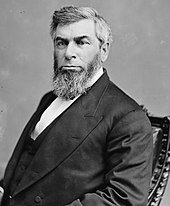Waite Court
| Waite Court | |
|---|---|

|
|
|
March 4, 1874 – March 23, 1888 (14 years, 19 days) |
|
| Seat |
Old Senate Chamber Washington, D.C. |
| No. of positions | 9 |
| Waite Court decisions | |
 |
|
The Waite Court refers to the Supreme Court of the United States from 1874 to 1888, when Morrison Waite served as the seventh Chief Justice of the United States. Waite succeeded Salmon P. Chase as Chief Justice after the latter's death. Waite served as Chief Justice until his death, at which point Melville Fuller was nominated and confirmed as Waite's successor.
The Waite Court presided over the end of the Reconstruction Era, and the start of the Gilded Age. It also played an important role in the 1876 presidential election, as five of its members served on the Electoral Commission that was created to settle the contested election. During the Waite's tenure, the jurisdiction of the federal courts was expanded by the Jurisdiction and Removal Act of 1875, which gave federal courts full jurisdiction over federal questions.
The Waite court began with the appointment of Morrison Waite by President Ulysses S. Grant to succeed Chief Justice Salmon Chase. Grant had previously nominated Attorney General George Henry Williams and former Attorney General Caleb Cushing, but withdrew both nominations after encountering opposition in the Senate. The Waite Court began with eight holdovers from the Chase Court: Nathan Clifford, Noah Haynes Swayne, Samuel Freeman Miller, David Davis, Stephen Johnson Field, William Strong, Joseph P. Bradley, and Ward Hunt.
...
Wikipedia
